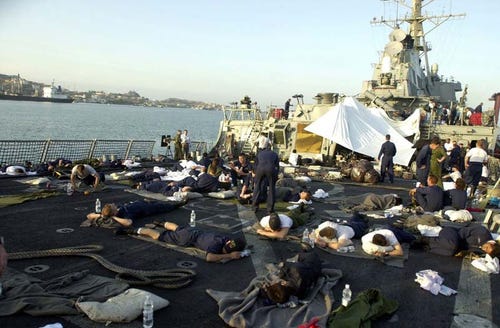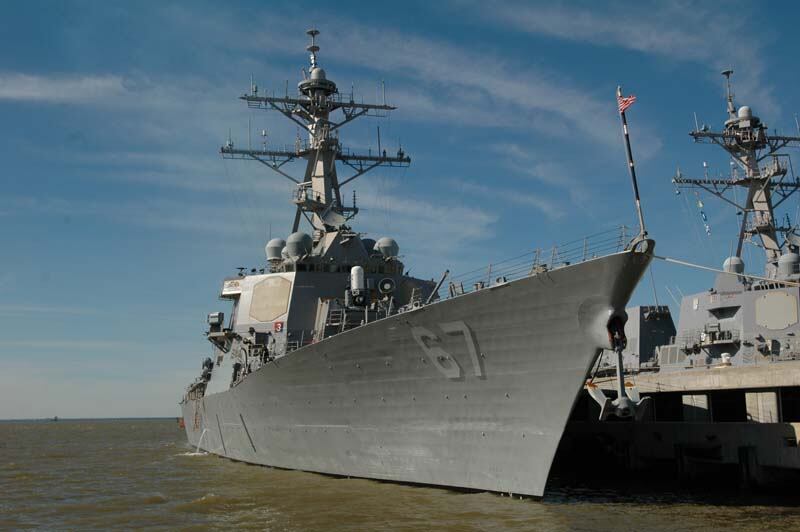source GAIA package: Sx_MilitaryTimes_M6201010010110316_5675.zip Origin key: Sx_MilitaryTimes_M6201010010110316 imported at Fri Jan 8 18:18:03 2016
The terrorist bomb attack on the destroyer Cole on Oct. 12, 2000, was a watershed moment in modern Navy history. It was also a wake-up call on the need for better force protection, damage-control training, intelligence sharing, shipboard equipment and mass-casualty response.
 Significant leaps forward in those elements have been made in the past 10 years, officials say — some of the steps prompted by changes mandated in the Pentagon's 2001 Cole Commission Report, others by debriefs and after-action reports.
Significant leaps forward in those elements have been made in the past 10 years, officials say — some of the steps prompted by changes mandated in the Pentagon's 2001 Cole Commission Report, others by debriefs and after-action reports.
 No area has advanced more than force protection, both in port and in transit.
No area has advanced more than force protection, both in port and in transit.
 "There's been a huge amount of change," said Capt. Sam McCormick, the anti-terrorism/force protection officer for Fleet Forces Command.
"There's been a huge amount of change," said Capt. Sam McCormick, the anti-terrorism/force protection officer for Fleet Forces Command.
Doctrine, organization, materiel, logistics, facilities and personnel requirements have been modified and training has been "totally revamped," he said. Afloat training groups train ships' reaction forces in basic and advanced techniques, and train their trainers as well. Ships cannot deploy without passing strike force certification training on anti-terrorism force protection, or ATFP.
Ships in port employ protective zones, security barriers and harbor security patrols. High-value units are escorted in and out of port, often by the Coast Guard, which has law enforcement capability. Gate sentries get specialized training. The master-at-arms force has increased fivefold since 2001.
In addition, the rules of engagement around the world have "been thoroughly reviewed and amended as appropriate," McCormick said. The standing rules are defined by the Joint Staff. In high-threat areas such as 5th Fleet, he said, those rules are modified by the combatant commander, who has sole responsibility for setting the threat level in his area.
Ship commanders formerly had wide latitude in how they handled ATFP but set their own force protection postures based on the threat level, he said. Cmdr. Amy Derrick-Frost, 5th Fleet spokeswoman, said commanders also coordinate extensively with host nation officials and U.S. Embassy country team officials and consider active intelligence and current threat assessments.
"One of the biggest pieces that came out of the attack on the Cole was truly a mindset change in the Navy," McCormick said. "When you have a successful attack in which, tragically, 17 sailors were killed and a billion-dollar warship was significantly damaged, that changes the psyche of the Navy."
When ship crews arrive in theater, he said, "They are leaning forward in their boots, they are vigilant to the extreme. Everything is possible. And we have to be prepared. We have to be on task, 24-7-365, when we're in the combat zone."
In addition, he said, the defensive concept of anti-terrorism operations applies globally. Guidance is aligned all down the line.
Citing security concerns, 5th Fleet reveals little about operational changes in the region, but said the rules for ships pulling into ports have been changed "to mitigate possible attacks." Multiple factors, such as threat assessments and host nation resources, go into deciding whether to enter a given port, Derrick-Frost said.
Asked whether Navy ships still stop in Yemen's Aden Harbor to refuel, Derrick-Frost replied, "U.S. Navy ships have not actively visited the port of Aden since the Cole tragedy."
The Pentagon report called for better rapid incident response. All Navy regional operations centers are now connected by a command-and-control network, McCormick said. From his base in Norfolk, Va., he said he can dial one number and be simultaneously connected to all six Navy regional operations centers in the U.S., both Navy numbered fleets, Navy Installations Command and the Naval Criminal Investigative Service.
"So if something happens on the West Coast, and we're alerted, I can immediately tell everyone in the nation," McCormick said. Overseas, combatant commanders' Maritime Operations Centers are similarly linked to the system, he said.
But, he added, "At the end of the day, it's still those sailors on the ship that make the difference. … If they're doing their job to the best of their ability, they're going to beat them."
McCormick emphasized the importance of U.S. forces remaining nimble enough to keep ahead of an elusive insurgent enemy.
"We've closed all the gaps that enabled Cole to happen, let's say," McCormick said. "But you know, we're up against a highly dynamic, innovative and adaptive enemy, who now has increased what they can do. Have we matched up to that? I'll be very honest with you: We found that we still have some work to do."
The Cole plays a highly visible role in Navy damage-control training, which begins in boot camp with the pre-graduation Battle Stations event. One of the improvements, and seminal events, that takes place aboard the realistic destroyer mock-up housed inside a building at Naval Station Great Lakes, Ill., is called "The Cole Scenario."
The room's mess decks have collapsed onto a berthing area — the opposite of what happened on Cole, but real-enough looking, officials say. There are dummy bodies and body parts scattered about the torn metal, and groups of recruits are sent down with stretchers to look for those who can be "saved," triage them and, if savable, carry them via stretcher back to a battle dressing station. The dummies make noise via built-in MP3 players, and trainers employ other special effects and lighting.
"We drive home to the recruits that the things they're learning here at boot camp, they need to take them to heart," said Chief Gas Turbine Systems Technician (Mechanical) (SW/AW) Karl Hacker, Battle Stations operations chief. The scenarios, he said, "all really happened in naval history. Real sailors lost their lives. We want to prepare them … so if this happens to them out in the fleet, it won't be the first time they've seen it."
The Cole simulator was launched in 2007, but Battle Stations began 10 years earlier. The former executive officer of the Cole, now-Capt. Chris Peterschmidt, said younger sailors on the Cole performed "phenomenally well" after the attack. When interviewed afterward, the sailors told officials, "We saw this before" — referring to their more-intense basic training.
The new training center, Peterschmidt said, is the "crown jewel" of Navy damage control training.
"In a way, every sailor coming into the Navy walks a little bit in the shoes of the sailors of the Cole," said Peterschmidt, now the operations officer for 3rd Fleet, who visited the mock-up in May. "Unfortunately, they only go through it once. They never go back to it again, and there's nothing like it, comparably, in any of the fleet concentration areas."
That training in damage control and mass-casualty response, as well as in other vital areas, gets reinforced out in the fleet by the afloat training groups — although one retired skipper said the philosophy of training the trainer neglects vital team-building. Retired Cmdr. Bryan McGrath, who commanded the destroyer Bulkeley from 2004 to 2006, maintains that the "dirty little secret" of this approach is that the trainers are a ship's very best watchstanders.
"For a good portion of the time … they train your more junior people," McGrath said. "Your absolute varsity, your very best people, almost never get trained operating as a unit, together. Your junior people definitely become better trained. Your No. 1 [group] never drills together, and never gets drilled. Because who do you use to evaluate them? Your second team?"
ATG damage control training, he said, "was satisfactory, it was good. They concentrated on the right things, the basics. I never felt like I could have enough of it. But it was probably among some of the better training that I thought ATG gave."
Equipment and gear changes, many quite small, were prompted by the Cole attack. Every surface warship and command ship now carries a "Cole Lessons Learned Kit," with items that came as a pleasant surprise to Peterschmidt when, in 2006, he took command of the destroyer Pinckney in San Diego.
"I noticed right away — oh, they fixed that!" Peterschmidt said, noting fixes as simple as adding fluorescent markings in the escape trunks to more accurately assess dewatering efforts in a darkened space.
Another simple change stemmed from the infections many Cole crew members suffered after cutting their hands while trying to get to the wounded after the blast — a "second wave of casualties," Peterschmidt said. The recommendation: leather gloves. Now, stacks are stashed in the DC lockers.
The mass-casualty response on the Cole is considered a strong point in the ship's response, particularly given the minimal resources available and the number of those in need. But dozens of recommendations out of a post-attack official briefing by the Cole medical team ended up being adopted by Navy medicine.
These included incorporating mass-casualty triage training into corpsman "A" and independent duty corpsman schools; removing inadequate standard body boards and replacing them with full-body-length backboards; distributing the working stock of medicines among different battle dressing stations; ensuring designated stretcher bearers serve continuously for at least six months; and ensuring that the medical lessons learned from the Cole are systematically passed on during training.
What the surviving Cole crew members could have used eventually came to pass not as a result of the Cole attack, but with the wars in Iraq and Afghanistan, and it's something Peterschmidt said he's observed with interest: a broader recognition of the mental health problems war can produce, and better means of screening for them.
"I think a lot of the crew was affected by the attack," Peterschmidt said. "We had one suicide, a month after." The Navy offered up services, he said, "but it was all voluntary." Peterschmidt said he's "very happy" to see the changes and the efforts to remove the stigma of reporting concerns. A lot of the Cole crew members, he said, "didn't seek out the treatment because they didn't understand what was happening, or [were] afraid of [the impact on] their career."
READ MORE:
• A decade later, few held responsible
• Could today's smaller crews survive an attack?




